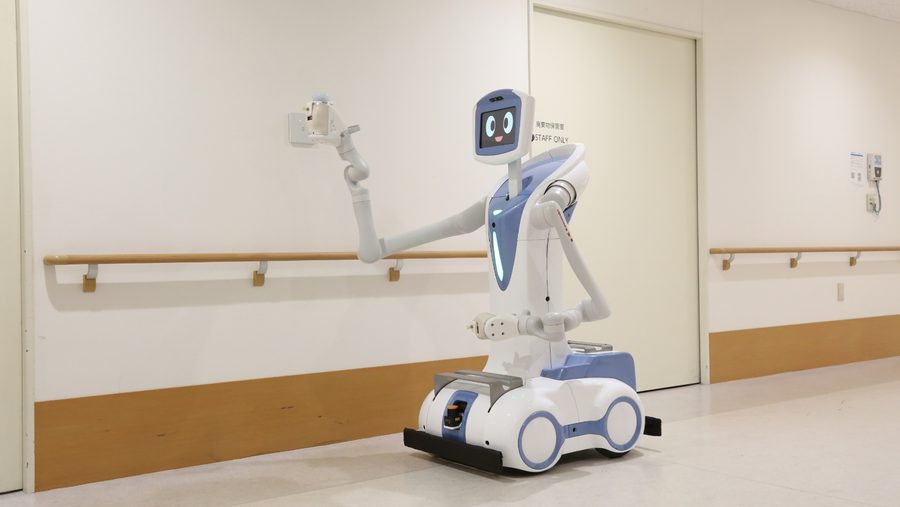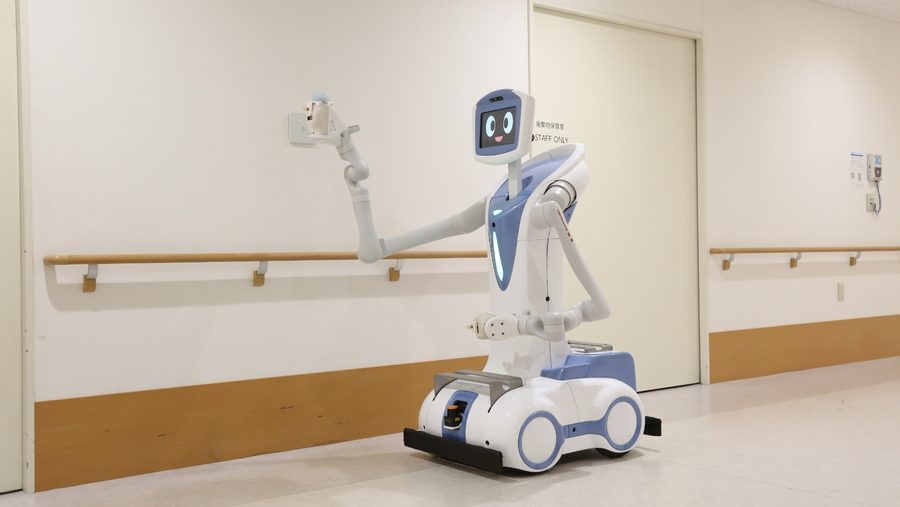Japan is in an era of population decline. Robots have so far only been used in limited areas such as the manufacturing industry. However, they are expected to be required in various other industries in the future. One of those industries is the service industry. In addition to chronic labor shortages, the coronavirus crisis has also increased the severity of the business environment for companies. Robots for the service industry. To achieve this, Kawasaki is developing the service robot Nyokkey.
A robot for the service industry – “Nyokkey”

Nyokkey is an autonomous mobile type service robot. It has been developed to work together with humans. It moves around in the same way as humans and performs work with two arms. Serving meals and clearing up dishes in a restaurant. Patrolling and supporting cleaning work in buildings. We are assuming applications in various scenarios. It is designed to have sufficient power to perform light works and to open and close doors while considering the safety of the people around.
Features of Nyokkey
Recognizing the location using LiDAR and vision sensors
With LiDAR, a laser beam is irradiated on the surrounding area and the reflections are used to create a map so that the robot can recognize its current location. In addition, object recognition using vision sensors is used to avoid collisions with people for safety.
Remote collaboration system “Successor”
The remote collaboration system, the Successor makes remote operations of a robot possible by using a communicator, which is a remote control device. Semi-automation is possible when performing operations that are difficult to automate, and switching to a remote operation from an automated operation or when an error occurs. This way, it is possible to respond to irregular situations. Skill transfer from humans to robots or vice versa is achieved by learning and memorizing the motions from the remote operations.
Autonomous traveling “AMR (Autonomous Mobile Robot)”
Compared with an AGV (Automatic Guided Vehicle), which travels along a preset route, an AMR can travel autonomously without setting the route. By setting the destination, the AMR judges the optimal route and moves based on the map information it has created itself and the surrounding environment.
Nyokkey as a co-creation platform
The premise for Nyokkey is that it will be adapted to suit the requirements. It is expected that the abilities and performance demanded of service robots will be even more diverse than those demanded of industrial robots. Based on the Nyokkey series hardware developed by Kawasaki, we will cooperate with various partners and go on to develop software that meets the needs in a quick development cycle. Nyokkey is a robot, and is also a platform.
Nyokkey development story
The development of Nyokkey began in the spring of 2021. In the situation where COVID-19 was wreaking havoc, we proceeded with the development as a patrol robot to watch over the patients in a hospital. The initial Nyokkey was to patrol the hospital rooms for remote checks of whether the patients were present and whether there had been any change in their conditions.
The purpose of Nyokkey was to reduce the infection risk for medical staffs and to support medical workplaces, which were under pressure. That development was conducted quickly and completed in less than a year from its beginning.
After that, further improvements were conducted and we arrived at the Nyokkey of today, which is designed with the assumption of a wide range of use in the service industry.
Examples of Nyokkey uses
Fujita Health University Hospital – Service robot demonstration testing

In January 2021, Kawasaki began demonstration testing for Nyokkey as one initiative in the smart hospital concept with the Fujita Health University Hospital.
In Phase 1, we conducted the transportation of goods such as specimens and pharmaceuticals, etc. within the same floor of the hospital, and movement to different floors with the assumption that a human would assist with the elevator operation.
In the current Phase 2, the verification is being performed for transportation between different floors using a robot that has arms, an autonomous mobile function and an elevator linkage function.
In Phase 3, we plan to conduct verification of a robot with multi-purpose arms performing work within the hospital, and verification of the collaboration with the hospital side systems.
Haneda Innovation City – Robot Cafe demonstration testing
At the end of April 2022, Kawasaki plans to open Future Lab HANEDA within Haneda Innovation City as a base to communicate information on robots. In the robot cafe named AI-SCAPE, we plan to conduct verification of Nyokkey recognizing the trays and tableware and performing the serving of meals and clearing up of dishes afterwards.
Kawasaki has a history of more than 50 years in the world of industrial robots. From now on, starting with applications to the service industry, for which the verification will be conducted at AI-SCAPE, we will offer robots for various workplaces to promote the implementation of robots in society in a way that goes beyond the framework of an industrial robot manufacturer.